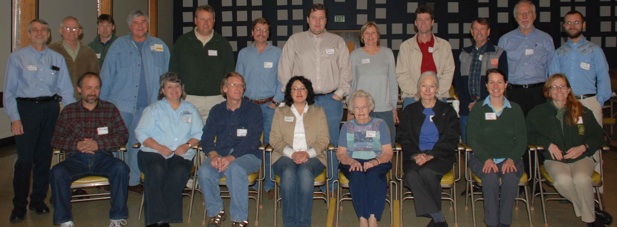COSAM » Donald E. Davis Arboretum » Alabama Plant Conservation Alliance » Minutes of APCA Meetings » February 6, 2009
Minutes from February 6, 2009

Minutes from the APCA/GPCA meeting Feb. 6, 2009
Held at Department of Agriculture and Industry Audtitorium, Montgomer, Alabama
Minutes taken by Dee Smith, Davis Arboretum, Auburn University
Attendees:
- Robert Boyd (Biological Sciences, Auburn University)
- Caroline Dean (Alabama Wildflower Society)
- Linda Derry (Old Cahawba, Alabama Historical Commission)
- Dan Everson (US Fish and Wildlife Service)
- Mike Hardig (University of Montevallo)
- Brian Keener (University of West Alabama)
- Harry Larsen (Forestry, Auburn University)
- Jan Midgley (Author, Educator, Grower)
- Jim Miller (US Forest Service)
- Fred Nation (Weeks Bay Reserve)
- Dale Pancake (Solon Dixon Center, Auburn University)
- Al Schotz (Alabama Natural Heritage Program, Auburn University)
- Ryan Shurette (US Forest Service)
- Dee Smith (Davis Arboretum, Auburn University)
- Keith Tassin (The Nature Conservancy)
- Patrick Thompson (Davis Arboretum, Auburn University)
- Amy Wright (Horticulture, Auburn University)
From GPCA:
- Jennifer Ceska (Coordinator, Georgia Plant Conservation Alliance)
- Ron Determann (Atlanta Botanical Garden)
- Lisa Kruse (Georgia Department of Natural Resources)
Summary of Events
Introduction by Bob Boyd
Presentation by Jennifer Ceska, GPCA Coordinator, which gave some background about GPCA. How it was initially formed, how they function and some of the conservation projects they have worked on. She stressed that the group is driven by projects rather that paperwork. The projects can be focused on a particular species, habitat, science or have an educational aspect.
There were 20 people attending and each introduced himself/herself and briefly described his/her plant conservation interests.
Ryan Shurette, USFS; Lisa Kruse, Georgia Dept of NR; Al Schotz, National Heritage; Jan Midgley, Native Plant grower, author; Linda Derry, Historical archeologist for Old Cahawba, Alabama Historical Commission; Keith Tassin, Nature Conservancy; Harry Larsen, retired forester, dendrologist; Dan Everson, US Fish and Wildlife; Fred Nation, Weeks Bay; Dale Pancake, Solon Dixon Center, forestry; Jim Miller, USFS; Ron Determann, Atlanta Botanical Garden; Brian Keener, University of West Alabama; Patrick Thompson, Davis Arboretum at AU; Amy Wright, AU Horticulture Dept.; Dee Smith, Davis Arboretum at AU; Caroline Dean, Wildflower expert; Jennifer Ceska, GPCA Coordinator; Bob Boyd, AU Biological Sciences.
After the introductions it was apparent that natural collaborations were already evident. Some of these were discussed during the lunch break that followed the introductions.
After lunch, it was decided that Bob Boyd would continue as the ‘temporary’ coordinator for the APCA. Go Bob!
Then followed a discussion of possible project ideas that APCA can consider adopting. General points made about these projects were that they:
- Should be feasible with existing resources.
- Might be selected by location (dividing the state into zones), or where the volunteers are who might be willing to work on them.
Possible projects discussed included:
- Ryan Shurette (US Forest Service) suggested projects involving control of invasive species and habitat restoration.
- The Nature Conservancy suggested green pitcher plant bog and canebrake pitcher plant site restoration. Removing privet in the green pitcher plant bogs would be a good project to align with the Alabama Invasive Plant Council (ALIPC).
- Ron Determann offered Atlanta Botanical Garden’s help by supplying plant material for restoration projects.
- Dan Everson (USFWS lead for several federally endangered AL plants) talked about the need to determine the number of populations of Sagittaria secundifolia (Kral’s water plantain)
- Linda Derry from Old Catawba needs help with plant inventory and expertise to base their management plan on for their 560 acres. Restoration of a canebrake site there was discussed, including planting methods as well as difficulties with propagation.
- Laurel wilt (an emerging threat to plants in the laurel family) suggested a project of high urgency. Two rare Lindera species may be at risk from this disease: Lindera subcoriacea and Lindera melissifolia (federally endangered). Collecting seeds this fall for seed banking and perhaps also establishing plants in collections were discussed as possible safeguarding activities that could form the heart of an APCA project.
- A question was asked about G1 species in Alabama and Brian Keener (UWA) mentioned Asplenium tutwilerae (a new species described by Brian and Larry Davenport) as being worthy of attention as it’s known from a single locality.
- The Pocosin at Troy AL was mentioned as a possible location for establishing a population of Matalea alabamensis, which might have only 1 extant Alabama population.
- There was much discussion on roadside wildflower planting issues, including the lack of seeds of natives and the need for management to establish good stands. Amy Wright (AU Horticulture) reported there is a project underway in her department to address some of these issues.
- Dale Pancake (Solon Dixon Center) reported a need for site inventory, management and documentation.
- Panhandle lily was discussed as a species that seems to be declining and in need of monitoring (such as at TNC’s Splinter Hill Bog).
- Monitoring efforts targeting species such as panhandle lily could be a good project for volunteers. It was suggested that we need a regional list of sites so that APCA members can see what’s needed close to their home institution.
In summary, a number of ideas were suggested and these form a basis for further discussion. It was suggested that the main agenda item for the next meeting be discussion of project ideas and formal adoption of several for action. Boyd said he would solicit additional ideas from those who could not attend this first meeting and present a list of ideas for the next meeting. He also suggested that participants send to him names and contact information for persons who were not on the list of contacts for this meeting, so that we could build our base of members.
The next meeting was tentatively set for May 8th at Birmingham Botanical Garden.
Meeting was adjourned at about 2:30 pm.
Last Updated: 05/04/2016
